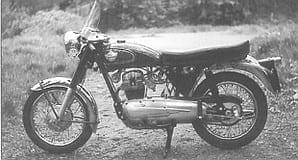
Overhead camshaft engines have been with us for a long while, much longer than many would think. In terms of motorcycle engines Peugeot, to quote just one example, had a double overhead camshaft racing engine in use well before the 1914-18 war. Harry Bashall, winner of the 1912 Junior TT on a 348cc Douglas, could recall competing against one very successfully with his TT winning mount at a French hill climb held at Mount Ventoux.
As far as the overhead camshaft engine was concerned, the big breakthrough occurred inappropriately on April 1, 1924, when Dougal Marchant took a 348cc ohc Chater-Lea with a much modified Blackburne engine to Brooklands. There he recorded a speed of 100.81mph over the flying kilometre in a one-way run – the first time a 350 had achieved the magic three figures. A couple of years later he was able to improve on this whilst enjoying a record-breaking spree in France. A two-way run rewarded him with a speed of 102.99mph for the flying start kilometre that was even faster than the existing 500cc World Record at that time!
He came away well satisfied with a total of 28 new World Records, all of them accomplished within a period of just 10 days. They encompassed every 350cc record, solo and sidecar, flying and standing start, from one kilometre to one hour.
Chater-Lea were by no means alone in perfecting the ohc engine. Veloce Limited had their own version available as early as 1924 and by 1926 had refined it to such an extent that they won the 1926 Junior TT by more than 10 minutes. Most of the other leading manufacturers were also developing their own engines of this type, although not all were unsuccessful. Sunbeam abandoned their project after inadequacies in the lubrication system ruined their chances in the 1924 Senior TT. Douglas were alleged to have lost their prototype in a fire at the factory during 1927, and Triumph never progressed beyond the prototype stage.
 Royal Enfield was an exception as they had other priorities. Until the mid 1920s they had been buying in proprietary engines and gearboxes which they fitted into their own cycle parts. Thereafter they decided to make their own engines rather than be reliant on outside suppliers. With all the associated design and development work this was no time to contemplate any diversion.
Royal Enfield was an exception as they had other priorities. Until the mid 1920s they had been buying in proprietary engines and gearboxes which they fitted into their own cycle parts. Thereafter they decided to make their own engines rather than be reliant on outside suppliers. With all the associated design and development work this was no time to contemplate any diversion.
Another 35 or so years were to pass before Royal Enfield showed an interest in having an overhead camshaft model in their range. The prospect came under discussion during a meeting at Redditch when the need to have a new lightweight model to their range was on the agenda.
Reg Thomas, their Chief Draughtsman at that time, proposed a 175cc model powered by a 64x54mm single overhead camshaft engine, no doubt influenced by the way in which the Italian lightweights were making serious inroads into the UK market. If engine capacity was reduced below the 200cc level, motorcyclists were at that time able to benefit from a reduced insurance premium. Ariel had already followed this route, firstly with their 197cc Colt and later, their 199cc Arrow 200, so with these points in its favour the idea was accepted. Reg Thomas was given the go ahead and in due course a prototype design was assembled and ready for testing.
After the engine had been run on the bench for a continuous 24 hours the test figures looked very promising, which was confirmed during a subsequent road test of the complete machine. The only problems encountered were oil leakage from the crankcase into the chaincase, and a broken rocker arm which brought the test to an end after 1,524 road miles had been covered. Presumably the testing would have continued after fitting a replacement part, but by then the production costings had become available. They were such that the whole project had to be abandoned.
Being broken up
From this point on the story took an unusual twist. Rather than being broken up or slowly stripped of parts to be used on other models, the prototype was given to Reg with a considerable number of spare parts and also the all important development records. Eventually, after it had found its way to a Royal Enfield dealer's window display in Bristol and one side of the petrol tank had faded to an orange colour, it passed into the hands of Ken Blake. Having a unique talent for finding the unusual, it was appropriate that it should end up with Ken, already well known for a whole series of restorations in the Poole area of Dorset. He set about a complete rebuild and it was not long before the prototype was up and running again.
The task was not as difficult as first might be imagined. With the machine he also acquired eight one-piece crankshaft assemblies, four cylinder heads, an assortment of domed pistons and cylinder barrels, numerous camboxes and timing pinions, and some unmachined crankcases!
Appearance-wise, the prototype has a hint of the Aermacchi Chimera about it, the flowing lines of the engine castings being continued back to the pillion footrests. Yet despite this, the engine itself is remarkably bland looking, showing little or no evidence it has an overhead camshaft. Typically Royal Enfield, the cycle parts include 16" diameter wheels with full width hubs. Surprisingly, the rear wheel is not quickly detachable, nor is there a removable end to the rear mudguard to help ease the wheel free of the machine in the event of a puncture, though one must remember this machine is only a prototype and not a production model.
Side valances
Both mudguards are chromium plated, with side valances, whilst the frame itself is of the pivoted fork type and looks as though it was made specially for the prototype. A good point is the use of snail cam adjusters at the fork ends to ensure rear wheel alignment is kept correct whilst adjusting the final drive chain, another Royal Enfield feature. Front suspension is taken care of by a conventional Royal Enfield telescopic fork. The red painted tank and the exhaust pipe and silencer seem to have been adapted from other models in the range, the silencer looking as though it would feel more at home on one of the company's two strokes.
 Reference to the development records makes interesting reading. Numbered 173/1, the original engine was on test from November 6, 1962 to March 27, 1963. During this period the crankcase oil leakage mentioned earlier was finally traced to blow holes in the casting. Whilst the engine was on the bench for its 24 hour continuous running the procedure followed was to sustain 5,000rpm for three hours, after which 6,000 and 7,000rpm respectively was held for a further half hour each. There followed a further quarter of an hour at 8,000rpm and five minutes at 9,000rpm, still without anything untoward happening. It was not until the engine revs were taken beyond the 9,000rpm mark that carburettor blow back set in at 9,100rpm, preventing any attempt to push up engine speed any further.
Reference to the development records makes interesting reading. Numbered 173/1, the original engine was on test from November 6, 1962 to March 27, 1963. During this period the crankcase oil leakage mentioned earlier was finally traced to blow holes in the casting. Whilst the engine was on the bench for its 24 hour continuous running the procedure followed was to sustain 5,000rpm for three hours, after which 6,000 and 7,000rpm respectively was held for a further half hour each. There followed a further quarter of an hour at 8,000rpm and five minutes at 9,000rpm, still without anything untoward happening. It was not until the engine revs were taken beyond the 9,000rpm mark that carburettor blow back set in at 9,100rpm, preventing any attempt to push up engine speed any further.
Perhaps it is just as well Royal Enfield never had the benefit of hindsight, as by 1965 UK motorcycle production had fallen to almost one third of what it was in 1959. The decline had set in and would gradually accelerate in the years that followed until virtually nothing was left, not even Royal Enfield of Redditch. ![]()
See also When was it that? contents





